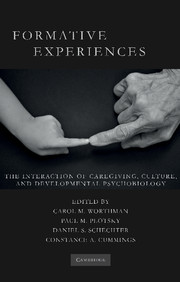Book contents
- Frontmatter
- Contents
- List of Figures
- List of Tables
- List of Contributors
- Foreword by Robert Sapolsky
- Preface
- List of Abbreviations
- Introduction
- SECTION ONE HISTORICAL, CROSS-CULTURAL, AND DEVELOPMENTAL SCIENCE PERSPECTIVES
- SECTION TWO HOW EXPERIENCE INTERACTS WITH BIOLOGICAL DEVELOPMENT
- SECTION THREE FORMATIVE RELATIONSHIPS WITHIN AND ACROSS GENERATIONS
- SECTION FOUR SOCIAL AND CULTURAL CONTEXTS OF CHILDHOOD DEVELOPMENT – NORMATIVE SETTINGS, PRACTICES, AND CONSEQUENCES
- SECTION FIVE FEAR, FUN, AND THE BOUNDARIES OF SOCIAL EXPERIENCE
- SECTION SIX PUBLIC HEALTH, EDUCATION, AND POLICY IMPLICATIONS
- Index
- References
SECTION THREE - FORMATIVE RELATIONSHIPS WITHIN AND ACROSS GENERATIONS
Published online by Cambridge University Press: 26 May 2010
- Frontmatter
- Contents
- List of Figures
- List of Tables
- List of Contributors
- Foreword by Robert Sapolsky
- Preface
- List of Abbreviations
- Introduction
- SECTION ONE HISTORICAL, CROSS-CULTURAL, AND DEVELOPMENTAL SCIENCE PERSPECTIVES
- SECTION TWO HOW EXPERIENCE INTERACTS WITH BIOLOGICAL DEVELOPMENT
- SECTION THREE FORMATIVE RELATIONSHIPS WITHIN AND ACROSS GENERATIONS
- SECTION FOUR SOCIAL AND CULTURAL CONTEXTS OF CHILDHOOD DEVELOPMENT – NORMATIVE SETTINGS, PRACTICES, AND CONSEQUENCES
- SECTION FIVE FEAR, FUN, AND THE BOUNDARIES OF SOCIAL EXPERIENCE
- SECTION SIX PUBLIC HEALTH, EDUCATION, AND POLICY IMPLICATIONS
- Index
- References
Summary
INTRODUCTION
This section focuses on the interaction of attachment and intergenerational transmission of aggressive behavior. Each of the case studies and commentaries that follow explores how, in the context of human development, the caregiving environment shapes the infant's experience, understanding, and expression of aggression. One of these case studies (Fouts) compares approaches to parenting that affect the very young child's understanding and expression of aggression in a hunter-gatherer society versus a neighboring agrarian society in the Congo Basin rainforest. Among other questions, this ethnographic case study raises the question of how culture potentially constrains caregivers' behavior and childrearing goals with outcomes that may or may not prove adaptive for a given society over time.
The remaining case studies describe formative violent experiences whose effects on the organism, in human (i.e., Busch & Lieberman and Schechter) and primate studies (i.e., Sánchez, McCormack, & Maestripieri), ripple across generations in biological and psychological domains that we are only now beginning to understand. The child's potential to become parent-victim and/or perpetrator of violence may have many determinants, not the least of which are the following: the developmental window of exposure (Moriceau & Sullivan, 2006), genetic and epigenetic vulnerability (Binder et al., 2008), the quality of infant-parent attachment, the larger caregiving system's attunement to the child's developmental needs, as well as the child's ever-evolving narrative construction of his or her own experience as influenced by family relationships, community, and cultural contexts (Madigan, Moran, Schuengel, Pederson, & Otten, 2007; Tremblay et al., 2004; Schechter et al., 2007).
- Type
- Chapter
- Information
- Formative ExperiencesThe Interaction of Caregiving, Culture, and Developmental Psychobiology, pp. 167 - 169Publisher: Cambridge University PressPrint publication year: 2010

